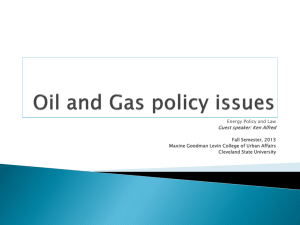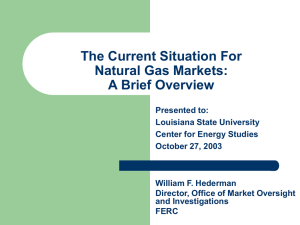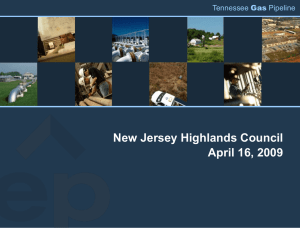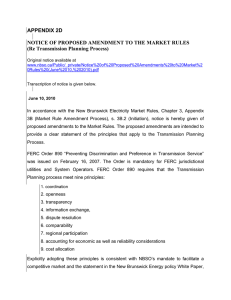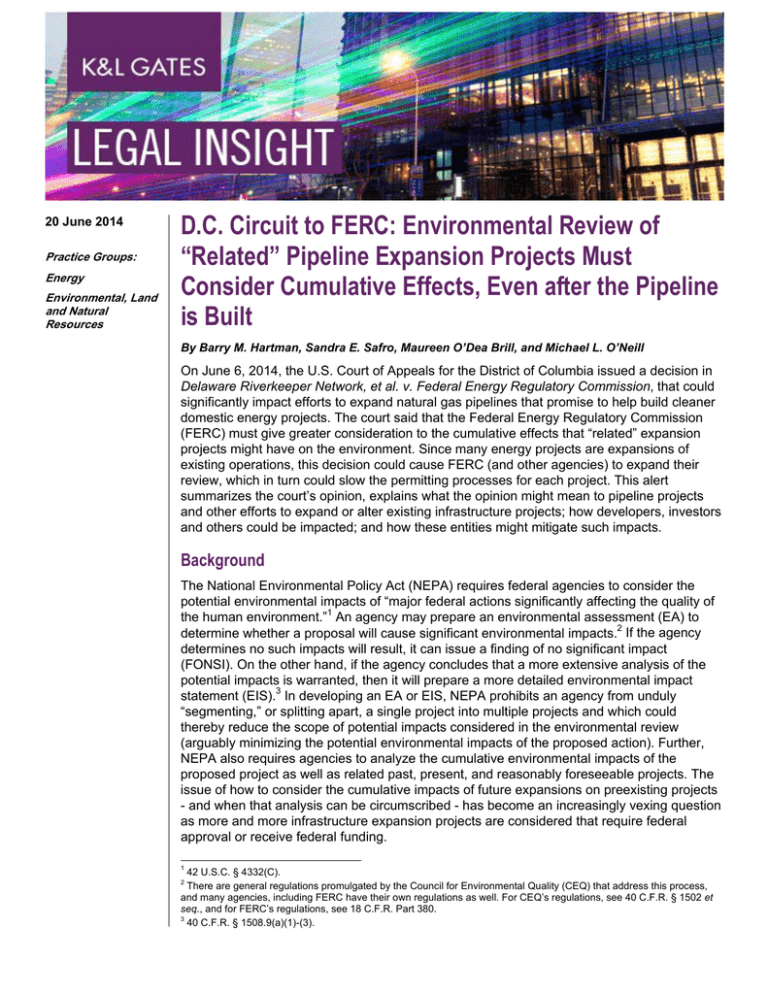
20 June 2014
Practice Groups:
Energy
Environmental, Land
and Natural
Resources
D.C. Circuit to FERC: Environmental Review of
“Related” Pipeline Expansion Projects Must
Consider Cumulative Effects, Even after the Pipeline
is Built
By Barry M. Hartman, Sandra E. Safro, Maureen O’Dea Brill, and Michael L. O’Neill
On June 6, 2014, the U.S. Court of Appeals for the District of Columbia issued a decision in
Delaware Riverkeeper Network, et al. v. Federal Energy Regulatory Commission, that could
significantly impact efforts to expand natural gas pipelines that promise to help build cleaner
domestic energy projects. The court said that the Federal Energy Regulatory Commission
(FERC) must give greater consideration to the cumulative effects that “related” expansion
projects might have on the environment. Since many energy projects are expansions of
existing operations, this decision could cause FERC (and other agencies) to expand their
review, which in turn could slow the permitting processes for each project. This alert
summarizes the court’s opinion, explains what the opinion might mean to pipeline projects
and other efforts to expand or alter existing infrastructure projects; how developers, investors
and others could be impacted; and how these entities might mitigate such impacts.
Background
The National Environmental Policy Act (NEPA) requires federal agencies to consider the
potential environmental impacts of “major federal actions significantly affecting the quality of
the human environment.”1 An agency may prepare an environmental assessment (EA) to
determine whether a proposal will cause significant environmental impacts.2 If the agency
determines no such impacts will result, it can issue a finding of no significant impact
(FONSI). On the other hand, if the agency concludes that a more extensive analysis of the
potential impacts is warranted, then it will prepare a more detailed environmental impact
statement (EIS).3 In developing an EA or EIS, NEPA prohibits an agency from unduly
“segmenting,” or splitting apart, a single project into multiple projects and which could
thereby reduce the scope of potential impacts considered in the environmental review
(arguably minimizing the potential environmental impacts of the proposed action). Further,
NEPA also requires agencies to analyze the cumulative environmental impacts of the
proposed project as well as related past, present, and reasonably foreseeable projects. The
issue of how to consider the cumulative impacts of future expansions on preexisting projects
- and when that analysis can be circumscribed - has become an increasingly vexing question
as more and more infrastructure expansion projects are considered that require federal
approval or receive federal funding.
1
42 U.S.C. § 4332(C).
There are general regulations promulgated by the Council for Environmental Quality (CEQ) that address this process,
and many agencies, including FERC have their own regulations as well. For CEQ’s regulations, see 40 C.F.R. § 1502 et
seq., and for FERC’s regulations, see 18 C.F.R. Part 380.
3
40 C.F.R. § 1508.9(a)(1)-(3).
2
D.C. Circuit to FERC: Environmental Review of “Related” Pipeline Expansion
Projects Must Consider Cumulative Effects, Even After They Are Already Built
As discussed in the court’s June 6 opinion, Tennessee Gas Pipeline Company’s (TGP) 300
Line is a natural gas pipeline transporting gas from production wells in western Pennsylvania
to delivery points in New Jersey, serving the Marcellus shale gas production region.
Recognizing dramatic production growth throughout the Marcellus shale play, TGP began to
upgrade the Eastern Leg of its 300 Line, some 200 miles of 24-inch gas pipeline, by adding
“looped” segments to increase transportation capacity for the pipeline. From 2010-2013,
TGP proposed four separate projects to upgrade its 300 Line. Pursuant to the Natural Gas
Act, TGP applied for four separate certificates of public convenience and necessity from
FERC for its 300 Line upgrade project.4 The third project in this sequence, the Northeast
Project, was proposed in March 2011.5
Each project required review pursuant to NEPA. FERC staff prepared an EA to analyze the
potential environmental impacts of the Northeast Project and addressed the potential
impacts of nearby pipeline and other infrastructure projects.6 It concluded the impacts would
be minimal and issued a Finding of No Significant Impact (FONSI).7 Thereafter, on May 29,
2012, FERC issued a certificate of public convenience and necessity for the Northeast
Project.8 In its order, the Commission concluded that the potential environmental impacts
from other jurisdictional pipelines in the area, including the two other 300 Line upgrade
projects already pending, would not contribute to significant environmental impacts.
Following an order on rehearing that reaffirmed the Commission’s earlier decision,
environmental groups appealed to the U.S. Court of Appeals for the District of Columbia
Circuit.9
The DC Circuit Rules: An integrated pipeline expansion project is not a
highway extension
The court concluded that FERC violated NEPA by (1) improperly segmenting the Northeast
Project environmental review from the three other 300 Line upgrade projects and by
(2) failing to meaningfully analyze the cumulative impacts of all four projects in its review.10
The decision establishes important law on the issue of improper segmentation, both for
pipeline projects and other infrastructure expansions generally.
Regarding segmentation, in developing an EA or EIS, the court said an agency must
consider the environmental impacts of connected, cumulative, and similar federal actions
and cannot unduly “segment,” or split apart, projects to minimize the impact. The court found
that FERC impermissibly segmented its NEPA review of the Northeast Project by not
considering the impacts of the three other “physically, functionally, and financially connected
and interdependent” upgrades to the 300 Line.11 Much of the court’s decision relies on its
4
15 U.S.C. § 717f(c)(1)(A).
Tennessee Gas Pipeline Company, LLC; Notice of Application, 76 Fed. Reg. 22,093 (April 20, 2011).
6
FERC, Tenn. Gas Pipeline Co., Northeast Upgrade Project: Environmental Assessment, Docket No. CP11-161-000, 2121 to 2-133 (Nov. 21, 2011).
7
Id. at 4-1 (Nov. 21, 2011).
8
Tenn. Gas Pipeline Co., L.L.C., 139 FERC ¶ 61,161 (May 29, 2012).
9
Del. Riverkeeper Network, et al., v. FERC, appeal docketed, No. 13-1015 (D.C. Cir. Jan. 22, 2013).
10
Del. Riverkeeper Network v. FERC, No. 13-1015, slip op. at 2-3 (D.C. Cir. June 6, 2014).
11
Del. Riverkeeper Network, slip op. at 5.
5
2
D.C. Circuit to FERC: Environmental Review of “Related” Pipeline Expansion
Projects Must Consider Cumulative Effects, Even After They Are Already Built
conclusion that when FERC issued its certificate for the Northeast Project, TGP’s intent to
upgrade the entire Eastern Leg of the 300 Line was evident.12
Rejecting FERC’s argument that the Northeast Project constituted an instance in which
segmentation was permissible,13 the court determined that there was no logical end point to
each of the four 300 Line projects,14 and importantly, that the Northeast Project did not
demonstrate substantial independent utility from the other projects.15 Comparing the 300
Line pipeline to a highway, the court viewed the pipeline as more similar to a highway that
“connects two major points [rather] than one section of a web of metropolitan roadways for
which the logical termini criterion loses significance.”16 Reinforcing its conclusion that the
four projects constituted a unified upgrade to the Eastern Leg, the court found that the
renovation projects shared a “temporal nexus,” since FERC knew of all four projects when
reviewing the Northeast Project application.17 Emphasizing the importance of timing, the
court noted that the ability to demonstrate the independent utility of a project improves as the
time between potentially connected proposals increases.18
Reasoning that NEPA regulations require an agency to consider the cumulative
environmental impacts of a proposal “when added to other past, present, and reasonably
foreseeable future actions” in developing an EA or EIS,19 the court concluded that FERC
failed to provide a meaningful analysis of the cumulative environmental impacts in its EA
justifying the FONSI. This is a separate issue from “segmentation” under a NEPA analysis,
as no matter how a project is split up for development purposes, it is incumbent on the
permitting agency to examine it for possible reasonably foreseeable and certain cumulative
impacts when considered in light of other existing or pending projects. The court’s analysis of
cumulative impact is relatively brief. Specifically, the court held that FERC must assess the
cumulative impacts of the four upgrade projects.20
What Now?
The court remanded the case to FERC for further consideration of the segmentation and
cumulative impacts issues. The decision explicitly directs the Commission to consider the
environmental impacts of the other 300 Line projects (due to its impermissible segmentation)
and to analyze the cumulative environmental impacts of the four projects (due to its failure to
provide a meaningful analysis in its EA). In its decision, the court does not comment on
whether FERC must consider the impacts of other pending similar, geographically close
projects, or state that FERC should produce one environmental document that analyzes all
12
During FERC’s review of the Northeast Upgrade application, FERC had approved one 300 Line project and had two
other 300 Line projects pending for environmental review and approval.
13
Del. Riverkeeper Network, slip op. at 20. The court referred to Taxpayers Watchdog v. Stanley, 819 F.2d 294 (D.C. Cir.
1987), for its four factors: (1) logical termini; (2) substantial independent utility; (3) does not foreclose the opportunity to
consider alternatives; and (4) does not irretrievably commit federal funds for closely related projects.
14
The court compared the 300 Line upgrading project to the construction of a highway connecting two major points, rather
than just one section of a web of interconnected metropolitan roads. Del. Riverkeeper Network, slip op. at 20.
15
Del. Riverkeeper Network, slip op. at 21. The court did not find TGP’s reliance on separate contracts for each upgrading
project of the 300 Line to be convincing evidence of “substantial independent utility. Del. Riverkeeper Network, slip op. at
21-22.
16
Del. Riverkeeper Network, slip op. at 20.
17
Del. Riverkeeper Network, slip op. at 25-26.
18
Del. Riverkeeper Network, slip op. at 26.
19
40 C.F.R. § 1508.7.
20
Del. Riverkeeper Network, slip op. at 27-28.
3
D.C. Circuit to FERC: Environmental Review of “Related” Pipeline Expansion
Projects Must Consider Cumulative Effects, Even After They Are Already Built
four 300 Line upgrade projects together. Given that the Northeast Upgrade is already in
service, environmental organizations are generally limited to advocating for FERC to require
enhanced mitigation measures.
Immediate Practical Implications
Some may say, so what? The projects are already built, so if the agency has to go through
an academic and theoretical exercise, it has no real world implications. Those who think this
do so at their own peril. Agencies rarely lose NEPA cases, and when they do, they often alter
their behavior to avoid future losses, and sometimes go farther than what is necessary to
avoid a future successful challenge. As a result, projects in the NEPA pipeline (pun intended)
after a loss like this can expect to face broader reviews and agency reluctance to expedite its
review.21 Future investors and developers should be concerned about the decisions that are
made with respect to additional environmental review of the Northeast Upgrade as these
decisions may well impact how FERC, and other agencies, consider future “related” projects.
To the extent possible, project developers and interveners should act to ensure that a
permitting agency satisfies the procedural requirements of NEPA with exacting attention. In
this case, it is likely the environmental groups will monitor this review process and seek to
shape how it is developed, hoping that the resulting process will impact future assessments.
The June 6 opinion raises a number of questions. For example, how will the agency decide
to conduct the NEPA reviews for other arguably “related” projects? Will it require the agency
to do one integrated EIS, or will separate ones that consider the cumulative impacts be
sufficient? What’s more, since this project is already built, the after-the-fact assessment
process has no time pressures, and if this process is adopted for future projects, even
greater delay could result.
From pipelines to ports and from rails to roads, projects requiring federal permits or receiving
federal funding routinely trigger NEPA reviews. In this era of expansion of oil and gas
infrastructure, the question of how these reviews will proceed for “related” projects will
recur.22 Developers and investors can contribute to the certainty and predictability of this
process. Viewing the NEPA process as presenting significant opportunities for constructive
engagement, interested parties can play a major role in ensuring that the record supporting a
federal action is complete and will withstand even the most demanding judicial review. Doing
so also assists the resource strapped permitting agency in processing an application, likely
speeding up the timeline for a decision, and minimizes the risk that a significant investment
will eventually be jeopardized in later litigation.
Since the decision is not uniquely applicable to any one type of project, those managing
projects which require NEPA reviews, not just those overseeing pipeline projects, will benefit
from an understanding of the decision. This is as true for project developers as it is for
21
This decision also calls into question the continued vitality executive branch policies or executive orders that that call
for federal agencies to undertake expedited environmental reviews. See, e.g., Exec. Order No. 13,274, 3 C.F.R. 250
(2002) (ordering executive agencies to expedite environmental reviews of “high-priority transportation infrastructure
projects”). See also Presidential Memorandum, “Speeding Infrastructure Development through More Efficient and
Effective Permitting and Environmental Review,” (Aug. 31, 2011) available at http://www.whitehouse.gov/the-pressoffice/2011/08/31/presidential-memorandum-speeding-infrastructure-development-through-more (last visited June 18,
2014).
22
In a recently filed case, the National Wildlife Federation sued the U.S. Army Corps of Engineers over “expansions” of
projects on the Mississippi River, alleging its EISs were inadequate, in part, because they did not consider cumulative
impacts of these projects. Complaint, Nat’l Wildlife Fed’n v. U.S. Army Corps of Eng’rs, 3:14-cv-00590 (S.D. Ill. filed
May 22, 2014).
4
D.C. Circuit to FERC: Environmental Review of “Related” Pipeline Expansion
Projects Must Consider Cumulative Effects, Even After They Are Already Built
federal agency staff. Countless federal highway expansion and extension projects face the
same potential vulnerabilities.
Looking ahead, as a result of the decision, agencies may take a conservative approach
when evaluating whether a project is impermissibly segmented. Potential ramifications of a
more broadly scoped environmental review include longer review periods and more
extensive mitigation requirements. Accordingly, project developers with proposals under
review or in development should proceed strategically and with a comprehensive
understanding of the court’s holding and rationale. Understanding what NEPA requires is the
key to navigating a project to its successful completion.
Authors:
Barry M. Hartman
barry.hartman@klgates.com
+1.202.778.9338
Sandra E. Safro
sandra.safro@klgates.com
+1.202.778.9178
Maureen O’Dea Brill
maureen.o’deabrill@klgates.com
+1.717.231.5832
Michael L. O’Neill
mike.o’neill@klgates.com
+1.202.778.9037
Anchorage Austin Beijing Berlin Boston Brisbane Brussels Charleston Charlotte Chicago Dallas Doha Dubai Fort Worth Frankfurt
Harrisburg Hong Kong Houston London Los Angeles Melbourne Miami Milan Moscow Newark New York Orange County Palo Alto Paris
Perth Pittsburgh Portland Raleigh Research Triangle Park San Diego San Francisco São Paulo Seattle Seoul Shanghai Singapore Spokane
Sydney Taipei Tokyo Warsaw Washington, D.C. Wilmington
K&L Gates practices out of 48 fully integrated offices located in the United States, Asia, Australia, Europe, the Middle East and South
America and represents leading global corporations, growth and middle-market companies, capital markets participants and
entrepreneurs in every major industry group as well as public sector entities, educational institutions, philanthropic organizations and
individuals. For more information about K&L Gates or its locations, practices and registrations, visit www.klgates.com.
This publication is for informational purposes and does not contain or convey legal advice. The information herein should not be used or relied upon in
regard to any particular facts or circumstances without first consulting a lawyer.
©2014 K&L Gates LLP. All Rights Reserved.
5

